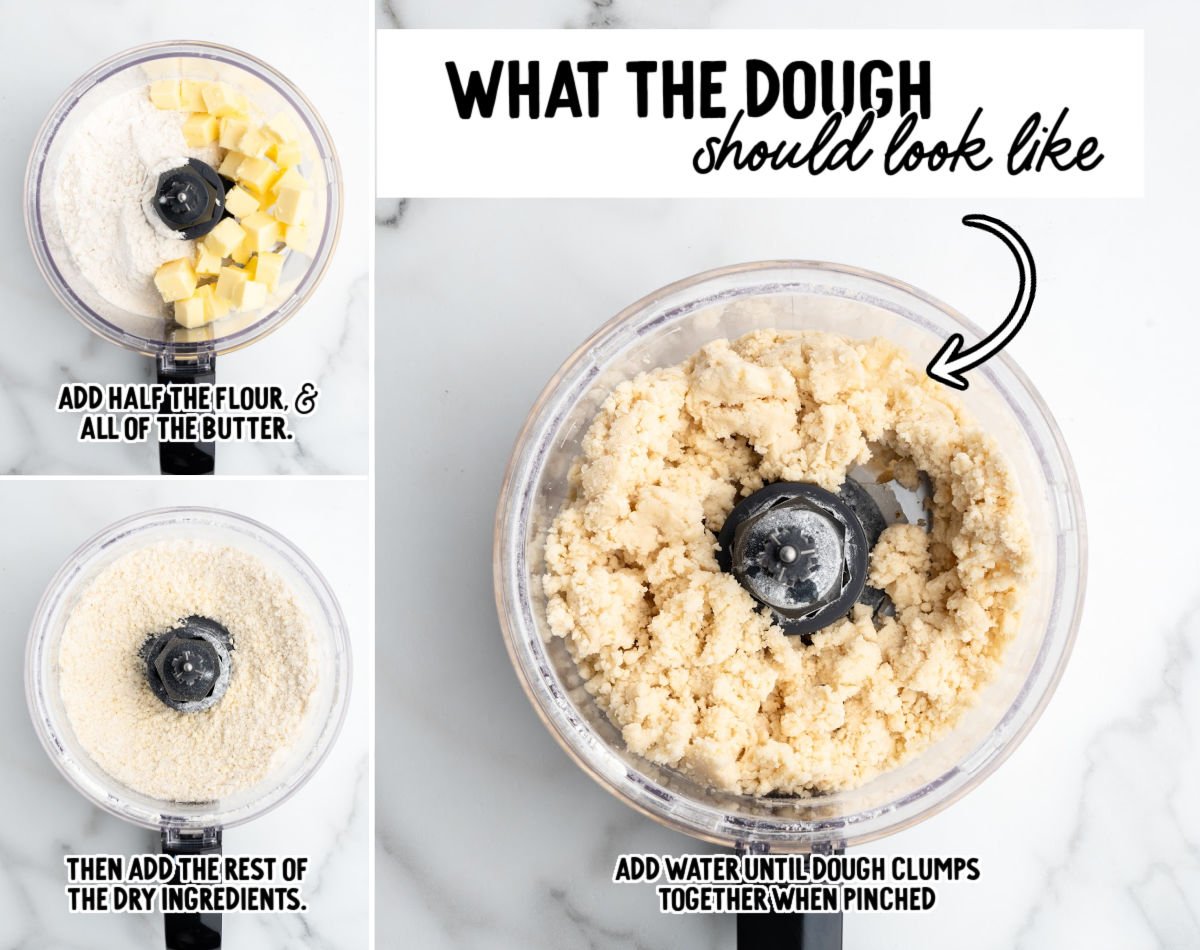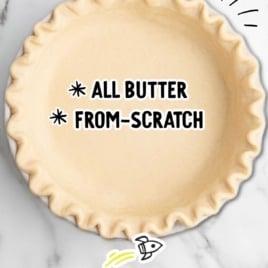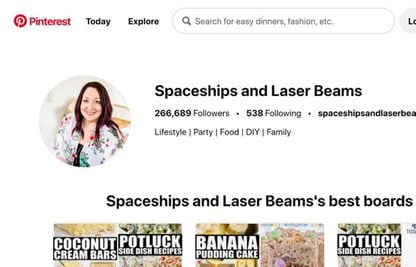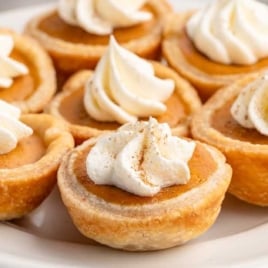Pie crust has a reputation for being tricky, but it doesn’t have to be. With this foolproof recipe, you’ll get a crust that’s crisp, tender, and perfectly golden every time.
Ingredients You’ll Need

Ingredient Notes
- Very cold butter and ice water aren’t just tradition—they’re essential. Cold fat hits the hot oven and creates steam pockets, which form those golden, crisp layers.
- This recipe calls for unsalted butter. If you are using salted butter, we would recommend cutting back or eliminating the salt in the recipe.
Tips For Making This Pie Crust Recipe
Full recipe in the recipe card below
Let the food processor do the hard work. This recipe has you pulse half the flour with the butter first, then add the rest. It might feel like an extra step, but it’s what gives you a crust that’s both tender and sturdy.

Pay attention to your water. Start with four tablespoons of ice water and add more only if the dough feels dry and crumbly—humidity makes a big difference (less in summer, more in winter). Don’t expect the dough to look perfect; if it clumps together when you pinch it, you’ve nailed the texture.
It’s tempting to roll it out right away, but letting the dough rest in the fridge keeps the butter cold and stops the crust from shrinking in the oven. Even one hour makes a huge difference.

We’ve tested rolling straight from the fridge, and the dough cracked badly. Letting it rest for five minutes makes it pliable but still cold enough for flaky layers.

To transfer the dough, roll it loosely around your rolling pin and gently unroll it into the pie dish. Let it settle naturally into the corners without stretching —through testing, we learned that stretching always leads to shrinking as the crust bakes.
Once the pie dough in place, trim off any excess dough from the edges leaving a 1-inch overhang. Carefully tuck under the dough to form a smooth, thick crust that comes all the way to the edge of the pie dish. You can then start crimping the edges of the crust to form a decorative border.

After you’ve shaped your crust in the pie dish, chilling it again for about 45 minutes may feel like an extra delay, but it’s the secret to a crust that holds its shape.
When the dough is warm, the butter softens and the gluten tightens, which makes the edges slump or shrink in the oven. Giving the crust time to firm up in the fridge keeps the butter cold (for flakiness) and relaxes the dough (for structure).
What To Do Next
Once it’s thoroughly chilled, you’re ready to go in two directions:
- Blind-baked pies: Follow the blind-baking steps in the recipe card if your pie filling doesn’t need to be baked.
- Filled pies: Add your chosen filling and bake according to your recipe (like our Chocolate Chip Pie)

Pie Crust Recipe
Equipment
- Food processor
- 9-inch pie dish (ceramic used)
- Plastic wrap
- Rolling Pin
- parchment paper
- Pie weights (commercial weights, dry rice or dry beans)
- Large rimmed aluminum baking sheet
Ingredients
- 1 ½ cups all-purpose flour, plus additional for dusting the work surface for rolling out the dough
- ½ cup unsalted butter, very cold and cubed
- 2 teaspoons granulated sugar
- ¼ teaspoon salt
- 4 to 6 tablespoons ice water (start with 4 tablespoons water then add more, one tablespoon at a time, if needed)
Instructions
- To the bowl of a food processor add half (¾ cup) of the all-purpose flour and cubed butter. Pulse 10 to 15 times or just until coarse crumbs form and all the butter is coated in the flour. Add the remaining half (¾ cup) of the all-purpose flour, granulated sugar and salt. Pulse 3 to 4 more times to fully incorporate.
- Remove the lid from the food processor and spoon 4 tablespoons of the ice water (remove any pieces of ice that may get into the mixture) over the flour mixture. Return the lid and pulse just until all the flour is moistened and the dough starts to come together. The dough mixture will look like very coarse sand but will easily come together when pressed between your fingers. If it is dry and crumbly, add an additional 1 to 2 tablespoons of water and pulse just until combined. Be careful not to overmix the dough or too much gluten will develop and the dough can be tough and may shrink too much when baked.
- Carefully remove the blade from the food processor, then turn out the dough mixture onto a piece of plastic wrap. Using the palms of your hands, gently press the dough together to form a ball, then flatten the ball to a disc about 6-inches wide by ¾ to 1 inch thick. Wrap the dough with the plastic wrap and refrigerate for at least 1 hour or up to 2 days.
- Lightly sprinkle 1 to 2 tablespoons of additional flour to a clean work surface. Remove the chilled dough from the plastic wrap and place onto the prepared surface. Allow the dough to rest for 3 to 5 minutes at room temperature before rolling out to a 15 to 16 inch circle that is approximately ⅛ inch thick. If the edges start to crack, you can gently press them back together and continue rolling out the dough.
- Using the rolling pin, gently roll up the pie crust to transfer it to your 9-inch pie dish. Allow the dough to settle into the dish as you unroll it off the pin. Gently press the dough into the sides of the dish without stretching, which can cause shrinking when baked.
- Using a small sharp knife, trim off any excess dough from the edges leaving a 1-inch overhang of dough. Carefully tuck under the dough to form a smooth, thick crust that comes all the way to the edge of the pie dish.
- Crimp the edges of the crust to form a decorative border. You can use any method of crimping you prefer (the pinch, also known as the flute, method was used for this crust). Be sure to press the dough firmly to the top of the pie dish when crimping. This helps keep the crust from shrinking too much when baked.
- Lightly cover the pie crust with a piece of plastic wrap and chill for an additional 30 to 45 minutes. Once chilled in the dish, you can either fill your crust with your preferred filling, following your specific recipe’s directions for filled pie baking. If you are blind-baking your pie crust you will need to follow the steps below.
Par-Baked and Blind-Baked Pie Crust (for pies that do not require being filled then baked fully in the oven)
- Once the dough has chilled in the pie dish, preheat the oven to 375°F.
- Remove the plastic wrap from the chilled pie crust. Place a large piece of parchment paper gently into the pie crust, carefully forming it up the sides. Add the pie weights to the parchment being sure to fill the dish at least two-thirds to three-quarters full. Spread the weights evenly in the dish to help the crust from shrinking, or bubbling, when baked.
- Place the pie crust filled with weights onto a large aluminum baking sheet then transfer to the center rack of the preheated oven. Bake for 20 minutes.
- Remove the pie crust from the oven and carefully lift out the weights using the edges of the parchment paper, then set them onto a heat-safe plate to cool.
- Using the tines of a dinner fork, poke holes all over the bottom, and up the sides, of the partially baked crust. This helps to keep the crust from bubbling up while it finishes baking.
- If your recipe calls for a par-baked crust, return the crust to the oven and bake for an additional 6 to 7 minutes, just until the bottom is set but not browned. Then proceed with filling and baking according to your recipe’s instructions.
- If your recipe calls for blind-baking (fully baked and cooled crust before filling) return the pie crust to the oven, once the pie weights and parchment are removed, and bake for another 15 to 20 minutes or until lightly golden and fully baked on the bottom. Allow the pie crust to cool completely before adding a chilled filling, or use according to your recipe’s instructions.
Notes
- This recipe is for a single 9-inch pie crust. If you are making a pie that requires a double crust, it is best to make a second batch of dough as doubling the recipe in the food processor can cause you to overwork the gluten in the flour when mixing. When the gluten is overworked, it creates tough dough that can shrink too much when baked.
- If using a good quality metal 9-inch pie dish, you will not need to place the dish onto a large baking sheet for baking as they can handle going from a cold refrigerator to a hot oven without warping or cracking. The reason for the use of the aluminum baking sheet is to slowly, and evenly, distribute the heat to the cold ceramic or glass pie dish. Some brands of pie dishes do not stand up to the extreme temperature changes well and can crack when placed into the preheated oven.
Nutrition
Pie Recipes You Can Make With This Pie Crust
Storing Instructions
You can make this classic pie crust recipe ahead of time. The dough can be made, shaped into a disc, and wrapped tightly in plastic to store in the refrigerator for up to two days.
Pie crust is a great option for the freezer. As long as your pie crust is wrapped tightly in plastic wrap or aluminum foil, and placed into a freezer Ziploc bag, it should last for about six months in the freezer.

Nothing beats a homemade pie, complete with a flaky crust. This pie crust recipe is a simple and easy way to make a homemade pie crust. It’s sure to take your pies to the next level!
Frequently Asked Questions
We recommend using a glass pie plate in this easy pie crust recipe. Glass conducts heat evenly when baking, and the glass dish will also allow you to see when the sides and bottom have browned.
If you don’t use enough water when preparing the dough, your pie crust will end up crumbly.
A tough crust results from there not having enough fat (butter or shortening) in your dough. Overworking the dough can also result in tough crusts.
Ensuring the butter is cold when blended into the crust helps prevent it from melting, and if the butter melts before baking, you will lose that flakiness that we all love so much in pie crusts.
















Comments
jay platte says
i made this with an apple pie, it was so delicious! will definitely have to make them again!
Gloria says
This is a classic recipe that everyone should have in their arsenal.
Gloria says
Can’t wait to try making this 😍